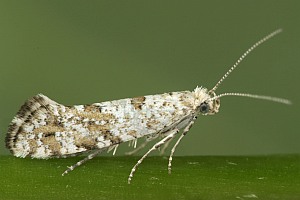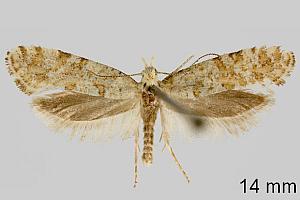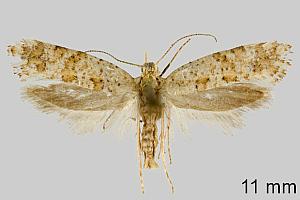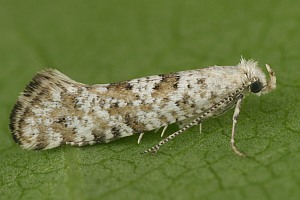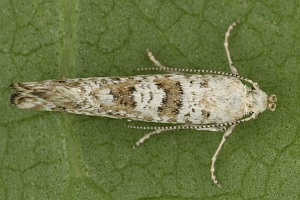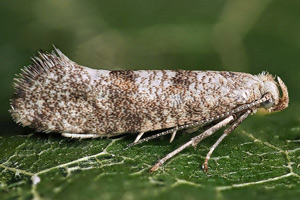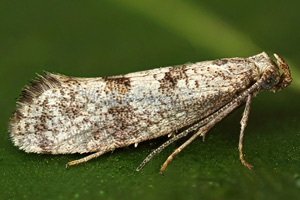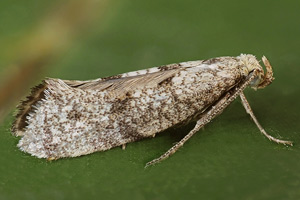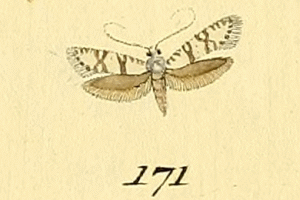

 +21Kontinente:EUAS
+21Kontinente:EUAS1. Lebendfotos
1.1. Falter
2. Diagnose
2.1. Männchen
2.2. Weibchen
2.3. Erstbeschreibung
3. Biologie
3.1. Nahrung der Raupe
- [Asteraceae:] Gnaphalium sylvaticum (Wald-Ruhrkraut)
- [Asteraceae:] Gnaphalium norvegicum (Norwegisches Ruhrkraut)
- [Asteraceae:] Helichrysum luteoalbum [= Laphangium luteoalbum, Pseudognaphalium luteoalbum, Gnaphalium luteoalbum] (Gelbweißes Ruhrkraut, Gelbweiße Strohblume)
- [Asteraceae:] Helichrysum arenarium ??? (Sand-Strohblume ???)
- [Asteraceae:] Filago arvensis ? (Acker-Filzkraut ?)
Nach Gaedike (1970) leben die Raupen in den Blütensprossen von Wald-Ruhrkraut (Gnaphalium sylvaticum) und Scheinruhrkraut (Pseudognaphalium luteoalbum). Schon Schütze (1931) hatte geschrieben: "Miniert nach der Überwinterung im März und April in den Blättern von Gnaphalium silvaticum und Gnaphalium luteoalbum und lebt im Juli und September in den Blütenköpfchen und Stielen. Rössler fand sie in Filago arvensis Blätter und Stängel minierend. Puppe in der Mine." Einige Literaturangaben erscheinen mir schlecht abgesichert zu sein, insbesondere zur Sand-Strohblume kenne ich keine überzeugende Quelle.
Überzeugend sind hingegen die Angaben zum Norwegischen Ruhrkraut bei Bengtsson & Johansson (2011) ("Larva in leaf, stem, and flower-head of Gnaphalium norvegicum, probably also other Gnaphalium spp.".
Välimäki & Mutanen (2015) studierten die Art intensiv in Finnland und lieferten dabei weit über das Land hinaus wertvolle Hinweise zu den Lebensraum-Ansprüchen der Art: "The main factors threatening lepidopteran species in Finland include the overgrowing of open habitats. As a consequence of changes for example in agricultural practices, quality and coverage of xeric meadows and leas on sandy soils have substantially degraded. We aim at illustrating the importance of human-made secondary habitats for lepidopteran species formerly associated with traditional agriculture using Digitivalva reticulella and its host plant Gnaphalium sylvaticum as examples. Digitivalva reticulella has severely decreased and considered as critically endangered by IUCN criteria in Finland. The species was re-discovered at the Ruka ski resort a few years ago, and its occurrence has been intensively studied in 2014 and 2015. Patchy population in Ruka is undoubtedly the most viable population of the species in Finland; presence of the species was detected in 29 discrete growths of G. sylvaticum. Moreover, we found ˃20 colonisable vacant G. sylvaticum patches in the area. Thus, anthropogenic degradation or loss of pristine habitats may create secondary habitats for threatened species, especially for those that are associated with habitats of early successional stages. Ski resorts serve as very promising secondary habitats as long as ski runs and road banks are being managed in an appropriate way. Instead of intensive landscaping, only moderate disturbance of field layer and natural early succession of vegetation should be preferred. Such a practice may not only turn out ecologically sustainable but also cost effective. We also learnt a practical lesson: instead of adult netting, searching for the larvae soon after the snowmelt is an effective way to map the occurrence of D. reticulella. The whitish mines of the larvae are easily detectable when surrounding vegetation has not yet properly developed."
(Autor: Erwin Rennwald)
4. Weitere Informationen
4.1. Etymologie (Namenserklärung)
Wahrscheinlich von lat. reticulum = das Netz, denn Hübner (1796: 62) erwähnt „in einander verschlungene, graubraune Streiffe“.
(Text: Jürgen Rodeland)
4.2. Andere Kombinationen
- Tinea reticulella Hübner, 1796 [Originalkombination]
4.3. Synonyme
- Lita cariosella Treitschke, 1835
- Digitivalva cariosella (Treitschke, 1835)
4.4. Literatur
- Bengtsson, B. Å. & R. Johansson (2011): Nationalnyckeln till Sveriges flora och fauna. Fjärilar: Bronsmalar – rullvingemalar. Lepidoptera: Roeslerstammiidae – Lyonetiiidae. ArtDatabanken, SLU, Uppsala, 494 pp. [Digitalisat (einige ausgewählte Seiten) auf nationalnyckeln.se].
- Gaedike, R. (1970): Revision der paläarktischen Acrolepiidae (Lepidoptera). — Entomologische Abhandlungen Staatliches Museum für Tierkunde Dresden 38 (1): 1 – 54.
- Erstbeschreibung (Tafel): Hübner, J. [1796-1834]: Sammlung europäischer Schmetterlinge 8: pl. 1-71.
- Erstbeschreibung (Text): Hübner, J. (1796): Der Sammlung europäischer Schmetterlinge achte Horde. Die Schaben; nach der Natur geordnet, beschrieben und vorgestellt: [1-12], 13-70, [71-78]. Augsburg (von dem Verfaßer).
- SCHÜTZE (1931): 197
- Välimäki, P. & M. Mutanen (2015): Jäkkäräverkkokoin [Digitivalva reticulella (Hübner, 1796)] ja sen ravintokasvin ahojäkkärän (Gnaphalium sylvaticum) esiintyminen Kuusamon Rukalla 2014–2015. — Baptria, 40 (3): 73-79. [PDF (ganzes Heft) auf perhostutkijainseura.fi]; Ergänzung des verloren gegangenen Teils: Baptria, 40 (4): 100. [PDF (ganzes Heft) auf perhostutkijainseura.fi]





















